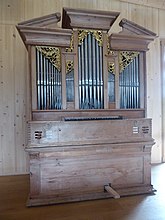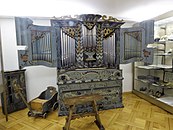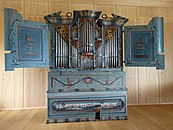Toggenburg house organ

Toggenburg house organs are house organs in the typical form of Toggenburg . The Toggenburg organ building comprises more than 100 instruments with dates from 1754 to 1821. They are decorated with carvings and painted with floral ornaments and rocaille work . The Toggenburg house organs were mostly played by women. With their festive sound, the instruments supported the pietistically toned house devotions .
Forerunners
In several European countries and especially in Alsace , where the art of organ building was practiced on a large scale, the house organs, popular for the maintenance of house music , developed in addition to church organs, especially in the 17th and 18th centuries . The free-standing instruments, usually equipped with lip pipes, were called positives , house, room or parlor organs.
In Switzerland, instrument making was originally done by carpenters until around 1700 individual specialists trained. After the organ was banned from the church by the Reformation , it was cultivated by music societies in the Zurich area - where organ building is well documented. Several organ builders are known there from the 1640s.
Toggenburg organ builder
Wendelin Looser
Wendelin Loosers (born April 14, 1720 in Kappel , † February 25, 1790) is probably responsible for establishing the art of organ building in the valley. He comes from the Protestant family Looser, which is very widespread in the upper Toggenburg . His known organs date from 1754 to 1781, but he probably built organs before that.
It is not known where Wendelin Looser learned his art. Knowledge of the origin of the paper key leaves used on all of his organs, bearing the (year) number 1710, could provide information. They probably come from his master's store.
Joseph Looser
Joseph Looser (born October 26, 1749 in Kappel, † March 7, 1822) was the son of the organ builder Wendelin Looser. He was introduced to organ building by his father at an early age and worked on his last works. Around 50 house organs emerged from Joseph Looser's organ building workshop. Joseph Looser held a number of offices, including that of mayor .
Johann Melchior Grob
Very little is known of Johann Melchoir or Hans Melchior Grob (born January 16, 1754 in Hemberg ). He moved his workshop from Hemberg to Ebnat, where he acquired citizenship and died on July 8, 1832. The three church organs in Gränichen , Lützelflüh and Payerne as well as four house organs can roughly be assigned (as of 2019) in the period from 1781 to 1813 . He renounced the double doors and the ornamental paintings in shades of blue. The body shapes of his organs are very different. It does not seem to have fallen prey to any schemata that can otherwise be found in the Toggenburg house organ building.
Ulrich Ammann
Ulrich Ammann (born February 13, 1766 in Alt St. Johann , † April 27, 1842) was of little importance as an organ builder. After Johann Melchior Grob turned him down as an apprentice, he spent four years building his own house organ from 1780 to 1784, which remained his only work. Ulrich Ammann later became famous for his “stick flutes” and “stick clarinets”, which French officers recognized as a mountain stick during the Napoleonic period and were valued as curiosities. In his will he gave secondary school Nesslau and primary school underwater with legacies .
Heinrich Ammann
Heinrich Ammann (born September 18, 1763 in Wildhaus ) built some house organs. In addition to the organ in the Toggenburg Museum , there is one in the Obermutten chapel , one in Tschiertschen's church and one in the Ackerhus Museum in Ebnat-Kappel. Ammann was proven to be a master carpenter in Wildhaus in 1814. He later moved to Grabs , where he died on January 2, 1836.
construction
The Toggenburg house organs are essentially made according to a uniform scheme. They are relatively simple positives , with the construction of which the low height of the living spaces had to be taken into account. In mostly of pine -crafted organ case bottom is the fan and above the wind box with the slider chest . This is a wooden frame that is divided into as many chambers as there are buttons. The whole case is painted with ornaments similar to the cupboards and chests of the time .
In the middle in front of the organist is the manual , which is closed with a sliding cover. It extends over four octaves and consists of 49 keys. At the top, the double doors reveal the prospect after opening , which consists of metal pipes arranged in different sizes. As is common in organ building, the pipes following one another in the scale are arranged alternately on the right and left (so-called C and C sharp sides) in order to avoid them.
sound
The labial pipes are open and covered wooden pipes and open metal pipes. The Toggenburg house organs are equipped with two to eight registers .
When all registers are used, Toggenburg house organs produce a room-filling, warm sound. They are therefore not only historically significant, but also musically valuable instruments and are particularly suitable for performing organ compositions by older (German) masters up to Johann Sebastian Bach .
distribution

Small positive organ by Joseph Looser without visible pipes, around 1780 ( peony painter )
|
In Toggenburg it is a spatially and temporally limited offshoot of the art of organ building that has been cultivated through two generations. This development was due to a special circumstance, Pietism . It was a movement that emerged in the 17th century within Protestantism and was very widespread in Toggenburg. The pietistic faith was kindled more in personal awakening than in scientific learning. In this way, the householder could be as worthy of preaching as an educated theologian . The first chambers in the Toggenburg houses provided an ideal space for meetings that were held in the shadow of one's own church.
The buyer of the house organs made by local artisans, evangelical families in parity Toggenburg, presented the instruments in the first chamber and used them for the care of sacred and secular music in the ceremonies. This came about during a period of prosperity brought about by the flourishing home industry beginning around the mid-18th century .
For the most part the Toggenburg house organs were in the upper and Neutoggenburg delivered. Similar instruments occur occasionally elsewhere, e.g. B. in the rest of Eastern Switzerland , in Valais , in Sumiswald or in Alsace.
The thesis that the house organ spread in Toggenburg to circumvent the Zwinglian ban on church music cannot be upheld . In the 17th century there was no religious music to be heard in any Reformed church in Eastern Switzerland . After around 1750 - very early compared to the neighborhood - the organ gradually returned to the Toggenburg churches. The first known Toggenburg house organ dates from 1754. The heyday of house organs falls in the last third of the century and lasted until shortly after 1810. At that time, church organs were already available in Kappel , Krummenau , Nesslau and, since 1788, in Alt St. Johann .
More pictures
literature
- Otmar Widmer: House organ building in Toggenburg. In: Anzeiger für Swiss Archeology: New Series. (archived in E-Periodica .ch )
- Text. Volume 39, 1937, Issue 2, pp. 135–154 (PDF; 11.9 MB)
- Supplement I and II. Volume 39, 1937, Issue 3, pp. 237–250 (PDF; 6.3 MB)
- Appendix III. Volume 39, 1937, Issue 4, pp. 309–322 (PDF; 8.9 MB)
Web links
Individual evidence
- ^ The Toggenburg house organ. Information sign in the Ackerhus Ebnat-Kappel Museum , visited on April 13, 2019.
- ↑ Hans Melchior Grob. On the website of Windbläss - Toggenburg House Organ Association, accessed on July 25, 2019.
- ^ Markus Meier: Johann Melchior Grob - Toggenburg organ builder. In: Toggenburger Jahrbuch 2014, online on the website of Windbläss - Toggenburg House Organ Association, accessed on July 25, 2019.
- ↑ Inscription on the Ammann organ in the Toggenburg Museum Lichtensteig, visited on July 25, 2019.
- ↑ Jost Kirchgraber: The rural Toggenburg house and its culture in the upper Thur and Neckertal in the period between 1648 and 1798. VGS Verlagsgenossenschaft, St. Gallen 1990, ISBN 978-3-7291-1056-4 , p. 66.
- ↑ a b Kirchgraber, p. 60.
- ↑ Kirchgraber, pp. 62–63.
- ↑ Kirchgraber, p. 65.








